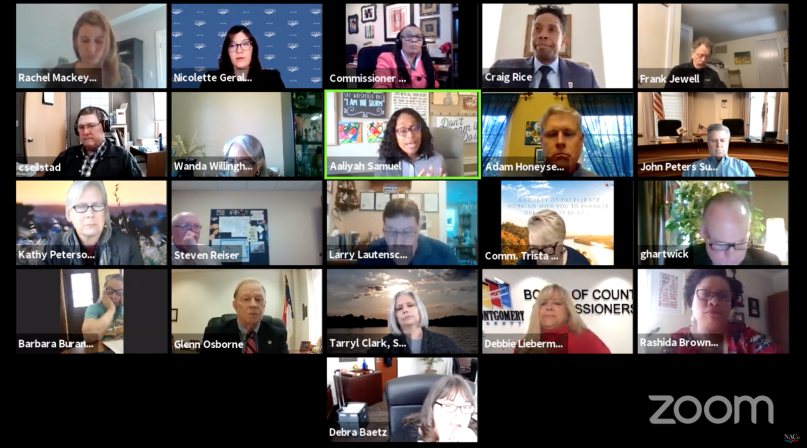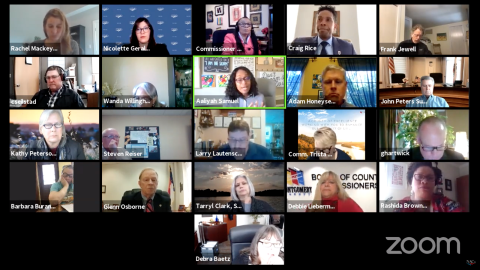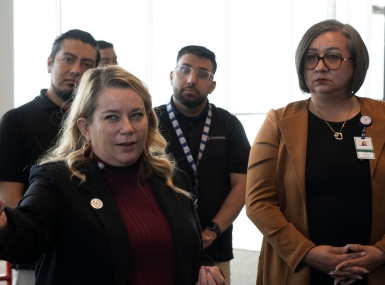Reopening schools key to addressing human services challenges
Author
Upcoming Events
Related News

Key Takeaways
The COVID-19 pandemic has left its mark on some of the nation’s most vulnerable.
One study predicts the world could lose as much as $10 trillion over the coming generation as a result of school closures in the wake of the pandemic, Aaliyah Samuel, deputy assistant secretary for State and Local Engagement at the U.S. Department of Education, told NACo’s Human Services and Education Policy Steering Committee March 8, on the first day of the 2021 NACo Virtual Legislative Conference.
One of the Biden administration’s priorities is to safely reopen all schools for in-person learning, Samuel said.
“Supporting a strong reopening, we feel, is not just the right thing to do, but it’s also the right investment,” she said.
The Department of Education has released the COVID-19 Handbook, Volume 1 which includes practical guidance for stakeholder engagement and community collaboration to develop strategies to safely reopen schools.
The second volume is currently being drafted and focuses on student and staff well-being, increasing investment for vulnerable students and addressing the loss of instructional time, according to Samuel.
Other education goals of the administration include early learning, teacher diversity and career and technical education.
“It really is going to take community support and thinking creatively to address the needs within the community which we know are certainly going to be there as we come out of this [pandemic],” she said.
A key challenge with the lack of in-person learning has been with food insecurity for children as well as millions of families who have been struggling to cover basic expenses, said Stacy Dean, U.S. Department of Agriculture deputy under secretary for Food, Nutrition and Consumer Services.
The food insecurity crisis is particularly urgent and has a disproportionate impact on communities of color, she said.
If passed by the House and signed by President Biden, the American Rescue Act provides more support to families by expanding the Pandemic Electronic Benefits Transfer into the summer and potentially next summer for kids missing meals, expanding meals to homeless youth who are living in shelters, investing in improvements for SNAP online purchasing and investing significant resources in Women, Infants and Children.
Carmel Martin, White House Domestic Policy Council deputy director for Economic Mobility, updated committee members on the Biden administration’s priorities for combating intergenerational poverty and for increasing equity in the wake of the pandemic.
According to Martin, the American Rescue Plan would lift 11 million people out of poverty, including 5 million children, a projection that would cut child poverty in half. The legislation would reduce poverty in Asian communities by 21 percent, black communities by 34 percent and Hispanic populations by 39 percent, she said.
“I think, big picture, we have to provide those immediate supports to people, but we also have to make sure that if we’re providing those supports and at the same time state and local government is forced to cut services, we’re sort of two steps forward and three steps back,” she said, emphasizing the need for funding that reaches the county level.
The American Rescue Plan includes the following for human services and education:
-
Child and Dependent Care Tax Credit, Child Tax Credit and Earned Income Tax Credit Expansion in 2021
-
Extended SNAP benefit increase through September and Pandemic-EBT Program through summer months
-
$130 billion for K-12 schools
-
Nearly $7.2 billion for distance learning
-
$39 billion in emergency support for Childcare and Development Block Grants
-
Permanent increase ($600 million annually) for mandatory childcare entitlement
-
$1 billion for Temporary Assistance for Needy Families emergency/cash assistance
-
$800 million for the special supplemental nutrition program for Women, Infants and Children
-
$1.4 billion for Older Americans Act programs
-
$1 billion for Head Start

Attachments
Related News

El Paso County, Texas helps migrants on their way
Though they don't often stay more than a day, asylum seekers receive care and services from El Paso County, Texas before they leave for their next destination.

L.A. County fends off homelessness with an assist from A.I.
A predictive model pulls data from six county departments to create a list of the county’s most vulnerable population — people who frequently show up in the county’s criminal justice and hospital systems and who access benefits like SNAP.

